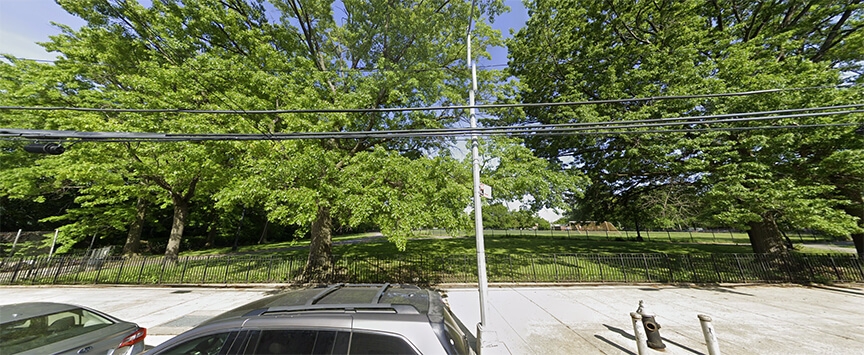On Nov. 14, the Gowanus Oversight Task Force — a community-based group tracking the 56 commitments that were part of the Gowanus rezoning — convened for the fourth time this year, this time to share with the public information about the Gowanus Business Improvement District (BID) and the city’s plans for green spaces in the neighborhood.
The Gowanus Rezoning Points of Agreement includes a commitment to create a Gowanus Waterfront Business Improvement District. A BID is a “geographical area where local stakeholders oversee and fund the maintenance, improvement, and promotion of their commercial district,” and supplements the city’s regular work. In Gowanus, the BID would focus on “stewardship, access, and public programming of open spaces, including new and existing waterfront esplanades, public parks, and streetscapes,” according to point 28 in the agreement.
From the city’s side, the work is led by the Department of Small Business Services (SBS), with the Department of City Planning helping in a limited role. SBS’s role is to oversee, strengthen and grow the BID, explained Leslie Velasquez, director of BID Development and Legislation at SBS.
Planning for the Gowanus BID began in 2021, and the project entered the outreach phase in October 2024, said Velasquez.
Presenting to the audience were also members of the BID steering committee, including Andrea Parker, executive director of the Gowanus Canal Conservancy. There is a need for ongoing investment and oversight to meet the needs of Gowanus, she argued. “Maintenance of our public spaces in New York City is sorely underfunded,” Parker said. To that end, the BID will serve an important role, for example as an advocate for public restrooms, cleaner streets and access to the canal.
The BID will also support flood mitigation and climate resilience efforts in the neighborhood, according to Parker.
Grace Freedman, co-chair of the community group Fourth on Fourth Avenue and part of the BID steering committee, also argued for the benefits of the BID, going as far as saying it can bring critical resources to Gowanus. ”There’s been a lot of development in this area, there’s been a lot of pain for neighborhood residents with that development, but it’s a really great opportunity to finally bring more attention and resources to this area. It’s very difficult in the city to get those resources and a BID is one of those ways, and I think it’s a fantastic opportunity to invest in greening, public art and small businesses,” she said.
The primary thing standing in the way of the BID is that it must receive enough support from property owners and commercial tenants. If it doesn’t get at least 51% support, the project can’t proceed. ”Our goal is to get to 51% by next summer so that the BID can enter the legislative phase,” Parker said.
Of the speakers from the committee, two came from advocacy groups and two were developers, perhaps an indication of what the BID will focus on if it gets past the legislative stage.
Following the presentation on the Business Improvement District plan, representatives took questions from the audience. Gowanus Dredgers Captain Gary Francis queried the committee about adding more points of egress to the canal, especially in light of the 69-year-old man who had been found dead in the canal earlier that day. No definitive answer was provided, but Parker said that floating docks and more access to the water from private properties are things the BID is looking at.
Another audience member asked about the risks of gentrification and pricing current tenants out of the neighborhood when the new developments come online and the waterfront becomes more attractive. City representatives could not say definitively that that won’t happen, but noted that during the pandemic, small businesses in commercial districts fared better than neighborhoods that didn’t have BIDs in place. (No data or source was provided supporting this claim, and we could not independently verify it.) Parker added that rents for affordable housing units can’t be raised because of the introduction of a BID.
Council Member Shahana Hanif attended the meeting as an audience member, and asked about obstacles and jobs. While she received a response to both her questions, it was unclear why an elected official heavily involved in the BID process was given space and time to ask questions at the expense of the community members whose questions went unanswered.
The Department of Parks and Recreation and the Department of Environmental Protection also presented on the future of public green space in Gowanus. No real news was shared with the audience, including on the development of Public Place. Elizabeth Ernish, project administrator with the parks department, called the park that’s scheduled to be built as part of the Gowanus Green redevelopment, ”Our big moment on the Gowanus Canal,” but did not have an update on when construction would begin. (She hoped they could start designing the park in 2025, but that will depend on other parts of the project.)
Author
-

I’m a New York-based journalist from Sweden. I write about the environment, how climate change impacts us humans, and how we are responding.
View all posts
I’m a New York-based journalist from Sweden. I write about the environment, how climate change impacts us humans, and how we are responding.










